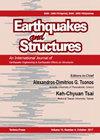中深柱低、中、高层钢结构建筑的延性要求
IF 1.1
4区 工程技术
Q3 ENGINEERING, CIVIL
引用次数: 1
摘要
为了减少位于高地震活动区的钢结构建筑的漂移,结构工程师使用深柱,尽管在一些研究中报道了深柱可能过早扭曲的意义。另一方面,在其他研究中,鼓励使用深柱。深柱钢结构建筑在循环荷载作用下的性能已经进行了试验研究,但没有考虑强运动和建筑动力特性的影响,以及相关的延性要求。在本研究中,根据位移和延性需求计算了中等柱钢结构建筑的地震反应,并与具有同等(相同重量)深柱的类似建筑进行了比较。结果表明,中柱模型的漂移量可能比深柱模型的漂移量大60%以上,表明采用深柱可以显著减小漂移量。在梁的局部延性要求方面的减少可能高达70%,但对于高层建筑柱的情况下,减少可以忽略不计。正如预期的那样,层间延性要求的降低幅度小于局部延性要求的降低幅度。虽然人们普遍认为非线性时程分析是最准确、最可靠的分析方法,但推覆分析被广泛用于估计不同参数下的地震反应;但深柱推覆时的层间延性要求要比动力分析时大得多。本文章由计算机程序翻译,如有差异,请以英文原文为准。
Ductility demands of low-, mid- and high-rise steel buildings with medium and deep columns
In order to reduce drifts in steel buildings located in high seismicity areas, structural engineers use deep columns despite what reported in some studies in the sense that deep columns can prematurely twist. In other studies, on the other hand, the use of deep columns is encouraged. The behavior of steel buildings with deep columns subjected to cyclic loading has been experimentally studied, but the effect of dynamic characteristics of strong motions and buildings, as well as the associated ductility demands, have not been considered. In this research, the seismic responses of steel buildings with medium columns are calculated in terms of drifts and ductility demands and compared to those of similar buildings with equivalent (same weight) deep columns. Results indicate that the drifts of the models with medium columns may be up to 60% larger than those of the models with deep columns implying that the drifts may significantly be reduced if deep columns are used. The reduction in terms of local ductility demands on beams may be up to 70%, but for the case of columns of high-rise buildings, the reduction is negligible. The reductions in story ductility demands are smaller than those of local ductility, as expected. Although it is generally accepted that nonlinear time history analysis is the most accurate and reliable analysis procedure, pushover analysis is broadly used to estimate seismic responses in terms of different parameters; however, the story ductility demands obtained from pushover while using deep columns are much larger than those of dynamic analysis.
求助全文
通过发布文献求助,成功后即可免费获取论文全文。
去求助
来源期刊

Earthquakes and Structures
ENGINEERING, CIVIL-ENGINEERING, GEOLOGICAL
CiteScore
2.90
自引率
20.00%
发文量
0
审稿时长
>12 weeks
期刊介绍:
The Earthquakes and Structures, An International Journal, focuses on the effects of earthquakes on civil engineering structures. The journal will serve as a powerful repository of technical information and will provide a highimpact publication platform for the global community of researchers in the traditional, as well as emerging, subdisciplines of the broader earthquake engineering field. Specifically, some of the major topics covered by the Journal include: .. characterization of strong ground motions, .. quantification of earthquake demand and structural capacity, .. design of earthquake resistant structures and foundations, .. experimental and computational methods, .. seismic regulations and building codes, .. seismic hazard assessment, .. seismic risk mitigation, .. site effects and soil-structure interaction, .. assessment, repair and strengthening of existing structures, including historic structures and monuments, and .. emerging technologies including passive control technologies, structural monitoring systems, and cyberinfrastructure tools for seismic data management, experimental applications, early warning and response
 求助内容:
求助内容: 应助结果提醒方式:
应助结果提醒方式:


